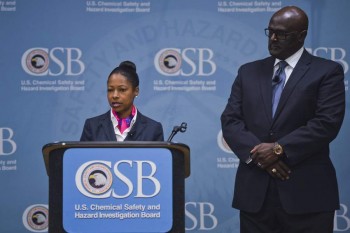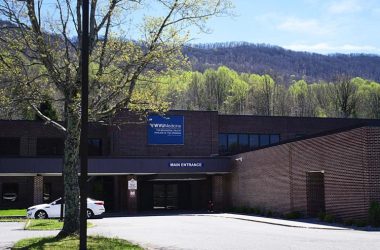
Chairwoman Vanessa Allen Sutherland of the U.S. Chemical Safety and Hazard Investigation Board answers questions after the release of a report on the CSB’s investigation into Freedom Industries and the January 2014 water crisis.
CHARLESTON, W.Va. — Criminal pollution violations, lax environmental enforcement and glaring regulatory gaps caused the January 2014 chemical spill at Freedom Industries, and then poor emergency planning and a confused response turned the incident into a region-wide drinking water crisis in the Kanawha Valley, federal investigators concluded in a much-anticipated draft report released Wednesday.
But U.S. Chemical Safety Board experts proposed precious few formal, concrete recommendations for avoiding a repeat of the disaster — and aimed none of the proposals they did come up with at federal, state or local agencies that regulate companies that store dangerous chemicals near public drinking water supplies or at the utilities citizens rely on to provide them with safe water.
In the 125-page draft, the CSB found that operators of the Freedom Industries facility along the Elk River ignored basic chemical tank safety standards and neglected important spill containment measures, while state and federal regulators did next to nothing to police the operation, despite its location just 1.5 miles upstream from West Virginia American Water’s regional drinking water intake that serves 300,000 people in Charleston and surrounding communities.
West Virginia American knew there was an industrial facility perilously close to its intake, but did not find out what was stored there or how dangerous it was, according to the report. State and local emergency planners received annual reports on Freedom’s chemical inventory but, like the water company, did not put together a plan for responding if any of those chemicals spilled into the Elk, the CSB found.
“My message here today is: What happened in Charleston was preventable,” Vanessa Allen Sutherland, who took over as the CSB’s chairwoman in August 2015 — more than a year into the board’s investigation of the Freedom incident — said during a morning news conference at a Charleston hotel.
The CSB’s report, more than two years in the making, was released Wednesday morning in draft form. Late Wednesday evening, at the end of a more than three-hour public meeting, members of the board unanimously approved the staff draft report and its recommendations, but also said they would re-examine some issues based on citizen comments and consider issuing an addendum, perhaps with some new recommendations.
CSB investigators described in their report a patchwork of confusing chemical tank safety standards, along with a multitude of gaps in what those rules require and how they are enforced. They found that emergency planning and response laws worked better on paper than in practice.
The draft report listed a variety of “lessons learned” for public water systems, regulatory agencies and the federal government. It said companies with chemical tanks near drinking water should closely monitor those tanks, states should maintain robust drinking water protection programs that consider the risk of such tanks, and local health officials should ensure they have adequate information about any chemicals stored near drinking water supplies.
But, the draft did not include any of these lessons as formal recommendations to federal agencies, like the Environmental Protection Agency, as part of specific strategies for how other communities around the country could avoid the problems found in the Freedom incident.
The draft report also did not make any formal recommendations to local officials or state agencies in West Virginia. CSB investigators concluded that West Virginia agencies and organizations “have established requirements and implemented practices that have addressed many of the gaps that [the] CSB identified early in its investigation.”
In their draft report, CSB officials touted passage by the West Virginia Legislature and the Tomblin administration of a new above-ground chemical tank safety law just months after the Freedom spill as a major step forward, but glossed over a major rewrite the following year as merely an effort to remove “some of the unintended consequences” of the original bill. Critics of that rewrite — they called it a “gutting” — said the board’s description inaccurately framed how much the state law was weakened in a legislative session that took place a year after the spill, when the public had largely moved on to other things.
Morgantown environmental consultant and House of Delegates candidate Evan Hansen, who investigated the spill and followed the legislation for the West Virginia Rivers Coalition, said the changes made in 2015 “did more than remove unintended consequences.”
“It significantly reduced the number of tanks subject to regulation, and it weakened the requirements for the tanks that are still regulated,” Hansen said.
The CSB report outlines the findings of several studies that showed large numbers of residents sought medical attention for exposure after Freedom’s spill of Crude MCHM and other chemicals, but also repeated twice — once in the narrative and again in a footnote — the claims of West Virginia government officials that the symptoms reported “could have been caused by other mild clinical illnesses, such as a cold, flu or viral infection.”
The report did criticize state and federal officials for providing confusing and conflicting information to the public about the safety of the water and the potential health effects of exposure to the leaked chemicals. But it also strongly blamed such confusion on inaccurate and untimely information from Freedom Industries and included little in the way of any analysis of West Virginia American’s decision not to close its drinking water intake until the spill had passed.
Also, the CSB report appears to suggest that a new state water safety study commission has urged Gov. Earl Ray Tomblin and the Legislature to adopt a long-standing board recommendation to create state and local chemical accident prevention programs, when in fact the commission has issued two annual reports in 2014 and 2015 and still not acted on a mandate that it advise lawmakers and the governor on that issue.
The draft report does not repeat the recommendation for new local or state safety programs, which originally was made by the board after an August 2008 explosion that killed two workers at the Bayer CropScience plant in Institute.
“I’m really disappointed by the lack of follow through on this recommendation and am hoping it was an oversight and not politics at play,” said Maya Nye, a local chemical safety activist who has pushed for implementation of the safety program. “Without it, it will be hard to get the governor or the Legislature to put the program in place.”
The CSB is not a regulatory agency, in that it does not issue citations or levy fines. Similar to the National Transportation Safety Board in mission, the CSB is charged with finding the causes of chemical accidents and recommending ways that private entities, government agencies and communities can protect against chemical incidents that threaten workers, the public or the environment.
Conspicuously absent from the CSB’s draft report is any specific reference to “inherently safer” design, equipment and processes, the safety concepts and proposals that Moure-Eraso had championed and said should be applied to the board’s Freedom probe.
The draft report, while repeating some of the narrative of the water crisis that is already familiar to Kanawha Valley residents, also provided a more detailed timeline and much new information about the specific history of the tanks at Freedom. It also confirmed what the CSB had said preliminarily — that agency investigators believe the leaked chemicals escaped from Freedom’s Tank 396 through two holes in the bottom of the tank that were no larger than pennies.
“The holes were caused by pitting corrosion that initiated on the internal surface of the tank floor,” the draft says. “The MCHM drained into the gravel and soil surrounding tank 396 and found multiple pathways into the river. The secondary containment or dike wall, originally designed to control leaks, had cracks and holes from disrepair that allowed MCHM to escape the containment. The leak also found a pathway to the river through a subsurface culvert, located under adjacent [tanks].”
The CSB draft says the tank that leaked was 76 years old at the time of the spill, having been installed in 1938, when the facility was operated by its original owners, Elk Refining. The tank had a capacity of 46,200 gallons. It was 20 feet in diameter and 20 feet tall. The bottom of the tank had, at some point — it’s not exactly clear when — been replaced, and some sort of a liner had been added to the floor, perhaps as a patch to repair earlier damage.
CSB investigators said it was impossible to determine the exact mechanism or timing of the tank leak, especially given the lack of data from Freedom about the amount of material contained in the tank before the leak being discovered on the morning of Jan. 9, 2014, when West Virginia Department of Environmental Protection inspectors responded to citizen complaints about odors from the facility, which turned out to be the strong black licorice smell of MCHM.
But the agency’s draft did explain that it is possible that leaks from the holes could have been jump-started by frost heaving, which the report described as when the freezing of water-saturated soil causes the deformation and upward thrust of the ground surface.
“Freezing weather prevalent at that time of year caused the frost heaving of the soil underneath the tank, which possibly led to the flexure or movement of the tank bottom in the vicinity of the holes,” the draft report said. This movement could have provided enough bending of the tank bottom or possibly dislodging the polyvinyl acetate liner or other debris blocking the holes, the report said.
Once the material became dislodged, the pressure from the MCHM in the tank “may have enabled the sudden gushing flow of liquid from the tank bottom,” the report said.
The CSB estimated that the flow of chemicals from the tank was about 11.5 gallons per minute, and that “the tank contents would have leaked through the tank holes and into the ground for approximately 24 hours (1 day) before the leak was detected.”
CSB investigators also said it’s possible that material had leaked from the tank earlier, and that its flow from under the tank and into the Elk River could have been slowed by the frozen ground.
But however exactly the leak occurred, Johnnie Banks, the CSB’s lead investigator on the Freedom case, said regular and appropriately performed inspections of the tanks would have identified the corrosion so that the incident could have been prevented.
“The best way to protect the public is not to have the leak in the first place,” Banks said.
Freedom Industries, which declared bankruptcy after the spill, and six of its former officials pleaded guilty to various federal Clean Water Act crimes related to the spill. One of those officials, Dennis Farrell, attended Wednesday morning’s CSB news conference.
“I just thought I would come and see what they had to say,” said Farrell, who spent 30 days in federal prison after his guilty plea.
The draft report includes formal recommendations aimed at the American Water Works Association, an industry group; American Water Works Co. Inc., the parent of West Virginia American; and Eastman Chemical, the maker of MCHM.
It recommends that the American Water Works Association communicate information from the “lessons learned” section of the report to its member companies around the country, and that American Water Works inventory chemicals stored near its intakes and develop concrete plans to respond to spills of those materials, and that Eastman Chemical update its previous safety data sheet for MCHM — which Eastman still produces — to include new findings from the spill investigation.
Candy Eslinger, a spokeswoman for Eastman, said the company already has revised its safety data sheet for Crude MCHM, and that the updated version was issued Sept. 15.
Reach Ken Ward Jr. at [email protected], 304-348-1702 or follow @kenwardjr on Twitter.





